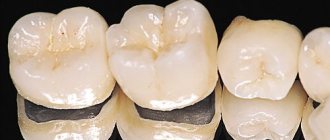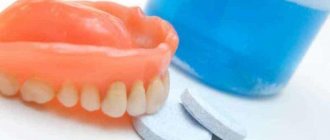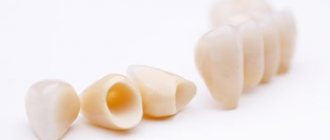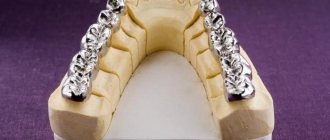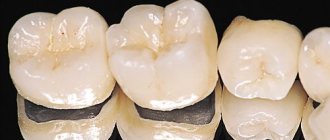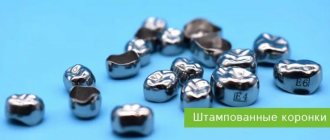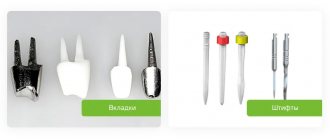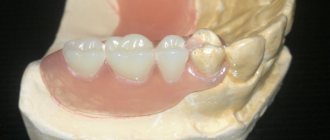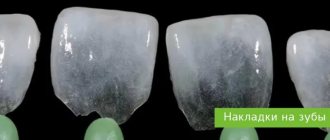April 2, 2019
Today, dentists offer their patients an acetal prosthesis as one of the methods for restoring teeth. However, patients have little objective information about this type of construction, which is why many choose those prostheses that have long been heard of - clasp, nylon or acrylic. So that you have an alternative, the editors of the UltraSmile.ru portal offer to analyze in detail information about the advantages of these products. Also at the end of the article you can find information about the disadvantages of acetal devices.
What kind of prosthesis is this and what features does it have?
An acetal denture is a partial removable [1] orthopedic structure made of synthetic resin (polyacetal). It is light and durable, allowing you to make comfortable dentures for installation on the upper or lower jaw with partial absence of teeth. Acetal is most often used to make crowns, hooks or clasps (fixing components), frames or arches, and less commonly - core inlays, gum formers for installation on implants. Removable acetal ones are attached to the supporting teeth using clasps.
%akc61%
Acetal removable dentures are distinguished from others by the shade of the clasps, frame (arch), and palatal bridge on the upper jaw. If, for example, clasp ones are gray metallic, and acrylic and nylon ones are translucent pink, then acetal ones are white or milky matte, not transparent.
Removable dentures on implants –
Conventionally, removable dentures on implants are called “conditionally removable”, because despite the fact that the patient can remove and put on such a prosthesis at any time, the latter is very securely fixed on the implants. This design is reminiscent of prosthetics with a clasp prosthesis with a locking fastening, only the micro-locks here are not on metal-ceramic crowns, but not on the protruding parts of 2-3 implants.
If you have a completely toothless lower jaw or toothless jaws with a high degree of bone atrophy, then good fixation of a removable denture can only be achieved using this method of prosthetics. In addition, such dentures have a significantly smaller denture base than complete removable dentures made of nylon or plastic. Some sources also call this type of dentures the term – overdentures.
Covering dentures on implants - prosthetic options
- Prosthesis on implants with a button-type micro-lock (Fig. 15-17) - 2-3 mini-implants are implanted into the jaw, into which spherical attachments are then screwed (they will protrude above the surface of the mucosa in the form of metal round heads). In the projection of the attachments on the inner surface of the body of the removable denture, recesses are made into which the fixing mechanism - silicone matrices - is inserted.
When you put on the prosthesis, the heads of the attachments fall into the fixing mechanism (silicone matrix), and the prosthesis is securely held. Such a prosthesis can never fly off on its own. You can remove it only by applying slight force with your hands. With such a denture, you will be able to chew comfortably, talk confidently with other people, without fear of the denture falling out.
- A prosthesis on implants with a beam-type micro-lock - 2-3 implants are also implanted into the jaw, onto which a metal beam is then fixed. In the projection of such a beam on the inner surface of the body of the removable denture, a recess is made corresponding to the exact size of the beam and one or more silicone matrices are inserted there, which, when putting on the prosthesis, will tightly grip the beam.
Covering dentures on intracanal implants –
There is also a cover prosthesis of another type. To implement such a prosthesis, it is necessary that the patient has 2-4 strong single-rooted teeth or at least the roots of teeth (preferably canines or premolars) left in the jaw. To make such a prosthesis, the crowns of the remaining teeth are first cut down to the root, and their root canals are filled.
Then implants are screwed into the root canal of each root (Fig. 28), resembling large pins, which will have an element in the form of a metal head protruding above the root (i.e., just like a prosthesis on implants with a push-button micro-lock).
On the inner surface of the prosthesis, in the projection of the metal heads, recesses are made into which silicone retaining matrices are inserted in the same way. As a result, you get excellent fixation of the prosthesis, comfortable painless chewing even of hard food, and due to the preserved roots of the teeth, the atrophy of the bone tissue of the toothless jaw slows down sharply, which helps to increase the service life of the prosthesis.
What material is used
Acetal (more precisely, polyacetal, polyformaldehyde, polyoxymethylene) is an organic thermoplastic compound discovered about 100 years ago. The material is initially crystalline and has a white, or rather milky color, and is opaque. Some manufacturers color the material according to the Vita scale in 15-17 shades for artificial teeth and pink shades for gums. The material is supplied marked: “Acetal plastic” or “monomer-free acetate plastic”. Quality brands – Evihard, Nuxen, Pressing Dental Srl
Acetal is hydrophobic, i.e. does not absorb oral fluid, saliva, or water at all. It is resistant to alkalis, but can be destroyed in an acidic environment, so you should be careful when consuming acidic foods and drinks.
In terms of strength, polyacetal can be compared with a cobalt-chromium alloy - they have approximately equal characteristics in terms of distribution of chewing load, resistance to abrasion and deformation during long-term use. The material melts at a temperature of 180 degrees Celsius, i.e. You can safely consume hot food and drinks. The absence of toxic acrylic monomer in the composition greatly reduces the risk of an allergic reaction.
Adaptation period
An important stage of wearing is adaptation; it is necessary to take into account a number of factors that may interfere with comfortable implantation. Patients often perceive normal manifestations and reactions of the body as such.
There are three stages of addiction:
- irritation;
— partial braking;
- full braking.
First
– observed almost immediately after installation. In this case, the structure is perceived as something foreign, diction disturbances, hypersalivation are noticeable, and the gag reflex may worsen. The second stage lasts up to five days, during which time all aggravated negative feelings return to normal, the gag reflex ceases to bother you, and salivation decreases to a natural level. The last stage lasts until the 33rd day maximum, during which time all aspects return to normal, discomfort completely disappears and the structure begins to be perceived as an integral attribute that does not cause inconvenience.
The situation is easiest for patients who have already worn the same or similar designs. In this case, the system takes root completely on the 7th day and all body reactions are much less pronounced during this period.
It is necessary to follow the rules of care so that the structure serves for a long time without problems. When removing, soaking in a disinfectant solution is required, and cleaning the oral cavity proceeds as usual.
Indications and contraindications
Indications for the installation of acetal prostheses are the following cases:
- the need to restore 1-2 or more teeth: for good fixation and load distribution, at least 6-7 teeth must be preserved in the row,
- the remaining teeth exhibit mobility of the 1st degree,
- increased abrasion of enamel,
- included and end defects: in the first case, teeth are preserved along the edges of the “gap” (where there is no tooth), in the second case there are no teeth at the edge of the row,
- inflammation of the gums: gingivitis, periodontitis,
- inconvenience in wearing other orthopedic structures: for example, if acrylic ones cause discomfort due to their massiveness, and clasp ones provoke galvanosis (the appearance of an electrical impulse between dissimilar metals),
- allergies to other synthetic materials and metals,
- the need for temporary prosthetics before implantation, if it is not yet possible to install implants.
Contraindications are such clinical cases as:
- complete or almost complete edentia (absence of teeth),
- pronounced mobility of the remaining supporting teeth,
- severe atrophy of the alveolar ridge (loss of bone and gums),
- allergic reaction to the material or increased sensitivity of the gums,
- small sizes of supporting crowns: hook-clasps will not be able to attach well to them, they will fly off or overload this area.
Comments
Which dentures are better: acetal, nylon or metal clasp? I’ve read different reviews on this topic, but I still can’t decide which prostheses I need.
Ulyana Vladimirovna (04/20/2019 at 07:22 pm) Reply to comment
- Dear Ulyana Vladimirovna! It is believed that acetal dentures are better than nylon ones, because Despite their similar flexibility, they are stronger and stiffer, holding better in the mouth. Also, acetal structures are cheaper than nylon ones, because the price of a material such as acetal is lower. As for the comparison of acetal and metal clasp devices, here you need to focus on the indications and personal preferences. Metal systems are more durable and stable, but they can cause long-term addiction and allergies, changes in taste in especially sensitive patients, but with acetal structures this probability is minimized. However, if periodontitis or periodontal disease is present, metal systems will be more preferable.
Editorial staff of the portal UltraSmile.ru (04/24/2019 at 09:17) Reply to comment
Write your comment Cancel reply
Types of orthopedic structures
The classification identifies several options for acetal dentures. Depending on the location of installation, it can be on the lower or upper jaw. In length – an immediate prosthesis (“butterfly”) for 1-2 teeth and an extended orthopedic structure that restores multiple and/or scattered defects in a row. As a rule, the last option is most often used, because The material is too hard for a butterfly.
As for popular varieties, they can be as follows:
- prosthesis with acetal clasps,
- clasp acetal dentures for the upper and lower jaws.
Clasp prosthesis made of acetal (without metal)
Such a device can be called a complete analogue of the clasp one. Only in acetal, the arch or frame is made of white acetal - there is no metal at all in this orthopedic design. Pink gum is built up on top of the arch; it can also be made of acetal or more transparent and elastic acrylic. Hooks or clasps are also made of acetal. Artificial teeth can be made from the same material, or they can be made from more pliable plastics. For attachment to the upper jaw there is an acetal palatal bridge. According to patient reviews, acetal dentures are lighter than classic clasp dentures with hooks, and are fixed in the oral cavity just as reliably.
Clasp metal with acetal clasps
In a traditional clasp denture, there is a metal arch inside and metal clasps on top - they grip the supporting teeth like small processes or “claws”. But when you smile, gray clasps can be noticeable. Therefore, it is allowed to make hooks from acetal, but leave the arc metal.
Read more about all possible prosthetic options for partial absence of teeth on one or two jaws.
Design features
The doctor minimally grinds the teeth for fastening elements. This is the main difference between acetal and plastic dentures.
Elastic acetal clasps practically do not injure the mucous membrane. If reliable and stable fixation is necessary, a combination with metal is used. The acetal insert acts as an attachment.
Manufacturing and installation
The dentist conducts a clinical examination and sanitation of the oral cavity. The design of the prosthesis is selected.
Upon completion of the preparatory stage, an impression is taken. It is always performed on both jaws to ensure correct bite correction. The impression is made from silicone compounds.
Model manufacturing algorithm:
- Creation of a plaster model in the laboratory.
- Applying wax rollers to the cast.
- The finished model with rollers is transferred to the dentist to determine the individual specifics of the bite and fitting.
- Model adjustment in laboratory conditions.
- Manufacturing of base and artificial units.
- Repeated fitting.
- Creation of a prosthesis from polyacetal.
- Installation of the product.
Standard technologies for installing prostheses are used. The structures are fixed to healthy teeth or artificial supporting bridges are used.
Features of care
The design features allow you to wear the prosthesis without removing it for up to three days. Twice daily cleaning of the oral cavity with non-abrasive pastes is necessary.
Special tablets will allow you to remove bacterial plaque from the surface of the product. The removable system is placed in a solution with water for the time specified in the instructions. Then the product is cleaned with a toothbrush. It is advisable to carry out ultrasonic cleaning in a dental setting.
Patients' opinions
Prosthetic structures are popular among patients and dentists. Despite the complexity of manufacturing, the prostheses demonstrate high performance. Patients quickly get used to wearing the products. Gentle fixation mechanisms do not injure tissue.
If one unit is lost, such a prosthetic design will become a temporary solution to the problem.
Installation restrictions:
- Loose units.
- Edentia.
- If you have braces.
- Malocclusion.
Avoidance of rough foods and thorough chewing will help speed up the addiction to the product. It is recommended not to remove the system for the first few nights.
Advantages and disadvantages
If we consider the pros and cons of acetal dentures, then they provide more benefits for patients - in comparison with conventional acrylic or even reliable clasp structures. The advantages of acetal products are as follows:
- good fixation on the teeth and uniform distribution of the chewing load (in comparison with acrylic ones): this is facilitated by fairly rigid acetal clasps and frame,
- ease of design and its installation in the oral cavity,
- good aesthetics: white clasps are not as noticeable on the teeth as gray metal ones,
- quick adaptation: the acetal removable denture on the upper jaw has only a thin bridge, and on the lower jaw there is a small imitation of gum, so it does not overlap the taste buds so much, distorts diction less, and does not provoke nausea,
- relatively simple care: there is no need to remove the denture every time after eating,
- acetal clasps put less pressure on crowns, so the enamel does not wear off as much as with metal hooks,
- flexibility and lower risk of breakage: the acetal frame can be bent 90 degrees, and it will not break or bend - it will return to its original position. Patients note that if they fall from a height (with careless handling), the prosthesis may not crack/break,
- you can get dentures for periodontal diseases, for loose teeth (but not in severe cases),
- low risk of allergies,
- low cost.
Disadvantages include factors such as:
- rigidity of the orthopedic structure: can provoke increased atrophy of bone tissue, loosening of teeth due to periodontitis (if the patient places or removes it incorrectly),
- as atrophy progresses, chafing on the gums, pain, stomatitis,
- when worn for a long time, you have to glue the prosthetic base onto a fixing cream (“Koregu” or “Protefix”),
- chewing with removable dentures is not very comfortable: only 6 out of 10 people say that they are relatively comfortable using removable devices,
- opacity of the material: therefore, the aesthetics here are lower than, for example, nylon,
- over time, the material absorbs dyes from food, becomes colored by tobacco smoke, darkens from plaque,
- there is a risk of breakage of individual clasps.
What are the disadvantages
In terms of their disadvantages, acetate prostheses are similar to vinyl (nylon) structures - they are often compared, although the first option is considered more durable and rigid. The material is characterized by increased elasticity, which facilitates the adaptation stage. However, over time, this plus turns into a minus. The main disadvantages of such systems are listed below:
- Over time, the material stretches, and this is reflected in the strength of fixation. The denture will begin to shift, which will create a feeling of mobility of the supporting teeth,
- with any mechanical impact, such systems will cause pain,
- the displacement will cause gaps to appear in which food debris will accumulate. This can lead to injury to the mucous membrane and accumulation of pathogenic bacteria in the oral cavity.
The prostheses are quite flexible.
Due to increased flexibility, the orthopedic system distributes the load worse, and the bone tissue underneath quickly atrophies. Over time, gaps form between the gums and the device, so it will have to be repositioned quite often, which is an additional cost. In addition, the material is porous, foreign odors quickly accumulate in it, and a coating forms on the surface. Unlike acrylic, acetalate is less easy to process. With insufficient care, artificial gums and teeth will quickly lose their aesthetic appearance, which will be especially noticeable in daylight.
How is production and installation carried out?
First, the patient undergoes diagnostics (examination, x-rays), sanitation of the oral cavity (removal of diseased and damaged teeth). After that, impressions are taken from the dentition, and an individual impression tray is made. Next, impressions are made again, a working model is made, and the future orthopedic product is cast and pressed on it.
The manufacturing technology of an acetal prosthesis is quite complex, and such a design is created only in a dental laboratory with modern equipment. Since acetal granules begin to melt at a temperature of 180 degrees Celsius, a thermal injection press will be required to make the prosthesis.
Then the finished structure or arch with clasps is cooled and tried on a model or directly to the patient. Next, gums are added to the frame, crowns are placed, the product is polished and sent for final fitting. If there are no shortcomings, it is installed for the patient.
Manufacturing of dentures from acetal
The production process of acetal prosthetic products for teeth requires painstaking work and highly qualified dentists and dental technicians. To achieve an ideal result, the creation of a prosthetic product at the Leaderstom clinic takes place in several stages:
- The attending physician conducts an examination of the oral cavity to determine the individual nuances of the future design.
- Impressions of the teeth are taken, and it is important to make impressions of both jaws so that the technician making the denture can see a complete picture of what the patient's oral cavity looks like.
- Creation of a plaster working model, on which the next several stages of prosthesis manufacturing are carried out.
- Plaster models are installed in special devices so that between them there is the same distance as in the oral cavity.
- In the laboratory, the model is installed in an articulator, where further adjustment of the prosthetic structure is made.
- Once the temporary model is ready and meets the specified parameters, the final version of the product is manufactured on its basis.
When the work is completed, the patient receives a prosthetic structure, which is made of durable but elastic material and will last for several years, restoring a natural, full smile and self-confidence.
Service life and care
The service life of a removable acetal prosthesis is 3-5 years. With good care it can be extended a little. To do this, you need to regularly remove the structure from your mouth for cleaning and disinfection (once every 1-2 weeks), because without proper cleaning, the surface will quickly darken. In addition, you need to brush your teeth twice a day - your own and artificial ones, using a special brush and toothpaste. To prevent breakage and displacement during the act of chewing, you should avoid hard and stretchy foods. Do not chew candy or nut shells, avoid toffees and toffees, and do not open jars with your teeth. You should also regularly visit an orthopedic dentist for examination and correction of the prosthesis, minor repairs and cleaning if necessary.
Care of acetal structures
The glass with teeth on the nightstand is a thing of the past. Acetal dentures do not need to be stored in liquid; it is enough to clean them periodically. Moreover, it is not recommended to remove acetal dentures at night - you will quickly get used to new teeth and a foreign body in your mouth if you do this in your sleep (no need to be afraid - the denture is well secured and will not pop out at night).
To disinfect the denture, immerse it in a special solution for 30 minutes a day. If it gets very dirty and there are pieces of food stuck between your teeth, clean it with a special brush for cleaning dentures. This is where the hygiene procedures end. The only thing that harms such a prosthesis is chlorinated tap water. Over time, it can break down the acetal, so use boiled or filtered water.
Alternatives to acetal prosthesis
An alternative among removable ones can be any partial removable one - acrylic, nylon, Acry-free. But the clasp and Quattro Ti (“Quadrotti”) are considered the closest, since they, along with acetal, have compact sizes and a thin palatal bridge for fixation on the upper jaw.
But these are all removable options that do not stop, and sometimes even worsen, the atrophy of the jaw bone tissue - experts recommend them only for temporary wearing. Therefore, the best way to permanently restore lost teeth is implantation. Here the orthopedic structures are attached most reliably, there is no need to remove them, and they are very easy to care for. Plus, bone atrophy stops, because the implant, as an analogue of the root, correctly transfers the load to the bone tissue.
“A former classmate once recommended a good dentist, who installed implants for my crowns. About prosthetics they said that only in six months. But without teeth you can’t walk, you can’t smile, you can’t talk. So the doctor chose a good acetal prosthesis for me. For a while. As long as I wear it normally, I haven’t noticed any problems. But, of course, I already want to get the crowns installed as soon as possible. There is no need to remove them to clean them.”
Sergey_76, review from irecommend.ru
Manufacturing stages
Dentists and dental technicians are involved in the process of making dentures. They do this in stages:
- The dentist takes an impression of the teeth and jaw to create a future design. They must be removed from both parts. This must be done to ensure that the shape of the prosthesis is convenient and comfortable for the patient.
- A scale model is created from plaster.
- Plaster models are adjusted to each other using professional tools. In this case, the dental technician must accurately take into account the position of the patient’s teeth.
- Prostheses are made using special devices.
- The finished structure is carefully polished and made to fit the patient’s jaw.
- The dentist provides the patient with a finished prosthesis for fitting. If there is severe discomfort, the structure may be sent for correction.
A removable denture is prepared in a short time. During the manufacturing period, the dentist offers the patient to wear a temporary structure.
Reminder for using a prosthesis
In the first few days after installation of the prosthesis, there is a feeling of discomfort, nausea, and a lisp. In some cases, increased salivation and nausea are observed.
Often all symptoms disappear after a few days. The duration of the habituation period depends on many factors, for example, the patient’s age, his emotional and mental state.
In order for the adjustment time to pass faster and without the manifestation of pronounced symptoms, as well as to eliminate possible complications, you should use the prosthesis correctly. To do this, you must follow a number of recommendations:
- Read aloud to restore diction. This is especially necessary for patients who are installing dentures for the first time. Based on medical research, it was found that the process of addiction takes much longer for them and can take from 1 to 3 months.
- how to remove correctly .
- If pain occurs during the first few days while wearing the device, you should put it on for 2-3 hours before visiting the doctor, eat, clean and put it on again. Only then contact a specialist.
- Protect the prosthesis from exposure to high temperatures. In order to preserve its original color and shine, it is recommended to exclude coffee from your diet. You also need to give up smoking, since tar and nicotine give artificial teeth a yellowish tint, which will be impossible to get rid of.
- Do not use the prosthesis if it is broken. This can lead to damage to the mucous membrane, the appearance of wounds and microcracks on the inside of the cheeks and lips.
- You should also not adjust or correct the design yourself. In case of breakdown, you must contact a specialist.
In some cases, when using metal fasteners, an allergic reaction may occur. It manifests itself in the form of swelling, redness, burning and pain when eating. If symptoms, discomfort or pain occur, you should consult a specialist.
What is an acetal clasp?
The structure, made of acetal, can be fixed using both acetal and metal clasps. Clasps are special hooks that tightly clasp the supporting teeth, securing the denture in the oral cavity.
The main advantage of this type of construction is that the hooks do not have a destructive effect on the enamel.
Polyformaldehyde clasps are highly durable. They are compatible with the tissues of the oral cavity and are completely invisible to others, which guarantees high aesthetics. Such hooks do not provoke an allergic reaction (unlike metal ones).
Acetal clasps do not damage enamel
At the same time, prosthetics using clasps does not always secure the structure absolutely motionless (in comparison with locks).
